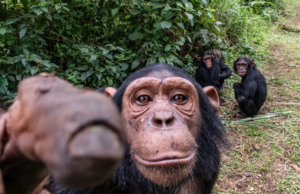Chimps’ champ

Chimpanzees and humans share about 99 percent of their DNA. If affinity and awareness count, Jane Goodall may have a smidge more.
As the world’s most renowned primatologist, she and her work have changed what we think of our primate brethren as thinking and feeling creatures, toolmakers, peacemakers and warmongers.
One of the original “Leakey Ladies,” anointed by the paleoanthropologist Louis B. Leakey, Goodall still returns twice each year to the chimpanzees of Gombe, Tanzania. In a world of fleeting celebrity, she remains both famous and influential. Although burdened with a disorder called prosopagnosia, which makes it hard to recognize faces, she herself remains instantly recognizable, her blond ponytail running to gray after 75 years.
Recently, after Goodall met Los Angeles Mayor Antonio Villaraigosa and his companion, Lu Parker, in South Africa, Parker Twittered: “Met Dr. Jane Goodall.
She says it’s not about fighting for animal rights, it’s about fighting for human responsibility. Clarity for me.” In September, Goodall’s latest book, Hope for Animals and Their World, will be published.
It’s almost 50 years since she and her mother stepped off the boat in Africa and gazed out at the forested valleys and slopes and wondered how she would even begin to find a chimpanzee to study. That, as it turned out, was the easy part.
Question: Have chimps taught you to think differently about people?
Answer: Learning about chimpanzees helped me to better visualize the long millions of years of human evolution and to some extent why we behave the way we do, and considering they’re so like us in so many ways, what’s the main difference? We have developed this spoken language that enables us to teach, to plan for the distant future.
Q: Why are humans so resistant to their kinship to animals, even primates?
A: It was the done thing among animal-behavior people, when I started, to think of humans as totally separate and different in kind as well as degree from the other animals. I never felt that way. I’ve definitely seen a change. (But) there’s a huge resistance in thinking about animals as having emotions, feelings, by anyone involved in invasive research — whether it’s putting animals in cages and experimenting on them, or the meat industry. It’s much easier to be nasty to creatures if you feel they don’t have proper feelings.
Q: They’re still used as performers and as pets — evidence Michael Jackson and Bubbles.
A: The whole use of chimps in entertainment means the baby’s been taken from the mother, will never have a normal life. When they grow up, they go off to medical research, they’re sent to lousy zoos in developing countries. Sadly, some people still think they’re cute and charming and (don’t) know anything about them in the wild at all, zero, nothing.
Q: With your Roots and Shoots project, you extended your work beyond chimpanzees to their habitat, then to the health of the planet. Why?
A: I was traveling around the world, talking about chimp issues and how everything’s interconnected, and (how) we need to be concerned about the forests because they sequester carbon which adds to climate change, blah blah blah.
It’s pretty pointless — anybody spending their life trying to save an animal or its habitat — if we’re not at the same time helping new generations to become better stewards than we’ve been. So Roots and Shoots is about projects to make the world better: one, for people; two, for animals; three, for the environment. It’s now in 110 countries with 10,000 active groups.
Q: So what can one human do?
A: I always say, “If you would spend just a little bit of time learning about the consequences of the choices you make each day — what you buy, what you eat, what you wear, how you interact with people and animals — and start consciously making choices that would be beneficial rather than harmful.”
Q: Are you more optimistic after 50 years’ work than you were when you began?
A: When I began there was no need to worry. All the terrible things we started doing to the planet environmentally really started after World War II. Things are very bad now. I think we’re almost at the point of no return, but we’re not there yet. The point of (my new) book is that it’s possible to turn things around if we get the political will.
Q: What’s your favorite depiction of yourself in pop culture?
A: Oh, a Gary Larson (cartoon) with two chimps grooming, and the female chimp pulling off this hair from the male and saying, “Hah, another blond hair. Been doing more `research’ with that Jane Goodall tramp?”
Pat Morrison is a Los Angeles Times columnist and host of a daily public-affairs show on Los Angeles public radio.
(C) 2009 The Los Angeles Times

 Español
Español
 Português
Português








